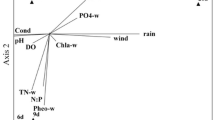Abstract
Microstratification of phytoplankton in the large shallow Lake Balaton (Hungary) was studied during a 24 h period. Dissolved O2 showed biological stratification; flagellates exhibited a definite circadian rhythm. In the middle of the investigation a heavy storm broke out which was followed by the disappearance of differences between different layers of water. Storm-induced destratification is described by cluster-analysis. Abundances of dominant species changed differently in connection with the storm. Numbers of Nitzschia sp. increased due to stirring up from the sediment surface. Numbers of single-celled or colony-forming species (Cyclotella comta, Crucigenia quadrata, Coelosphaerium kuetzingianum) practically did not change. Numbers of all the three dominant filamentous species (Aphanizomenon fos-aquae f. klebahnii, Lyngbya limnetica, Planctonema lauterbornii) significantly decreased, which might be attributed to an unknown loss process and was followed by a competitive displacement by algae of small cell size.
Similar content being viewed by others
References
Crumpton, W. G. & R. G. Wetzel, 1982. Effects of differential growth and mortality in the seasonal succession of phytoplankton populations in Lawrence Lake, Michigan. Ecology 63: 1729–1739.
Dokulil, M. & C. Skolaut, 1986. Succession of phytoplankton in a deep stratifying lake: Mondsee, Austria. Hydrobiologia 138: 9–24.
Entz, B., 1980. Physical and chemical microstratification in the shallow Lake Balaton and their possible biotic and abiotic aspects. In Dokulil, M., H. Metz & D. Jewson (eds). Shallow lakes. Contribution to their limnology. Developments in Hydrobiology 3. 63–72. W. Junk Publ. The Hague, Boston, London.
G.-Tóth, L., 1982. Numbers, biomass and production of algae smaller than 10 µ in Lake Balaton. Aquacultura Hungarica (Szarvas) 3: 145–158.
G.-Tóth, L., J. Padisák, 1978. Short-term investigations on the phytoplankton of Lake Balaton at Tihany. Acta Botanica Acad. Sci. Hung. 24: 187–204.
G.-Tóth, L. & J. Padisák, 1986. Meteorological factors affecting the bloom of Anabaenopsis raciborskii Wolosz. (Cyanophyta: Hormogonales) in the shallow Lake Balaton, Hungary. J. Plankton Res. 8: 353–363.
Hummon, W. D., 1974. A similarity index based on shared species diversity used to assess temporal and spatial relations among marine Gastrotricha. Oecologia (Berl.) 17: 203–220.
Istvánovics, V., 1988. Seasonal variation of phosphorus release from sediments of shallow Lake Balaton, Hungary. Wat. Res. 22: 1473–1481.
Istvánovics, V., L. Vörös, S. Herodek, L. G.-Tóth & I. Tátrai, 1986. Changes of phosphorus and nitrogen concentrations and of phytoplankton in enriched lake enclosures. Limnol. Oceanogr. 31: 798–811.
Lund, J. W. G., 1971. An artificial alteration of the seasonal cycle of the plankton diatom Melosira italica subsp. subarctica in an English Lake. J. Ecol. 59: 521–533.
Lund, J. W. G., C. Kipling & E. D. Le Cren, 1958. The inverted microscope method of estimating algal numbers and the statistical basis of estimations by counting. Hydrobiologia 11: 143–170.
Margalef, R., 1960. Temporal succession and spatial heterogeneity in phytoplankton. In Buzzati-Traverso, A. A. (ed). Perspectives in marine biology: 329–349. Univ. Calif. Press, Berkeley, Los Angeles.
Padisák, J., 1980. Short-term studies on the phytoplankton of Lake Balaton in the summers of 1976, 1977 and 1978. Acta Botanica Acad. Sci. Hung. 26: 397–416.
Padisák, J., 1985. Population dynamics of the dinoflagellate Ceratium hirundinella in the largest shallow lake of Central Europe, Lake Balaton, Hungary. Freshwat. Biol. 15: 43–52.
Padisák, J., L. G.-Tóth & M. Rajczy, 1988. The role of storms in the summer succession of the phytoplankton community in a shallow lake (Lake Balaton, Hungary). J. Plankton Res. 10: 249–265.
Rajczy, M. & J. Padisák, 1983. Divdrop analysis — a new method for interpretation of species importance in diversity changes. Annal. hist-nat. Mus. natn. Hung. 75: 97–105.
Reynolds, C. S., 1983a. A physiological interpretation of the dynamic responses of populations of a planktonic diatom to physical variability of the environment. New Phytol. 95: 41–53.
Reynolds, C. S., 1983b. Growth rate responses of Volvox aureus Ehrenb. (Chlorophyta, Volvocales) to variability in the physical environment. Br. Phycol. J. 18: 433–442.
Reynolds, C. S., 1984. The ecology of freshwater phytoplankton. Cambridge Univ. Press, Cambridge.
Reynolds, C. S., H. R. Morison & C. Butterwick, 1982. The sedimentary flux of phytoplankton in the south basin of Windermere. Limnol. Oceanogr. 27: 1162–1175.
Reynolds, C. S., S. W. Wiseman & M. J. Clarke, 1984. Growth- and loss rate responses of phytoplankton to intermittent artificial mixing and their potential application to the control of planktonic algal biomass. J. Appl. Ecol. 21: 11–39.
Reynolds, C. S., S. W. Wiseman, B. M. Godfrey & C. Butterwick, 1983. Some effects of artificial mixing on the dynamics or phytoplankton populations in large limnetic enclosures. J. Plankton Res. 5: 203–234.
Sneath, P. H. A. & R. R. Sokal, 1973. Numerical taxonomy. Freeman, San Francisco.
Sommer, U., 1981. The role of r- and K-selection in the succession of phytoplankton in Lake Constance. Acta Oecol., Oecol. gen. 2: 327–342.
Squires, L. E., M. C. Whiting, J. D. Brotherson & S. Rushforth, 1979. Competitive displacement as a factor influencing phytoplankton distribution in Utah Lake, Utah. Great Basin Naturalist 39: 245–252.
Szebellédy, L. (ed.), 1970. KGST Egységes vizvizsgálati módszerek (COMECON methods of water chemical analyses) I. Vituki, Budapest.
Tamás, G., 1975. Horizontally occurring phytoplankton investigations in Lake Balaton, 1974. Annal. Inst. Biol. Acad. Sci. Hung. 42: 219–279.
Vörös, L. & N. Kiss, 1985: A fitoplankton szezonális periodicitása és annak összefüggése az eutrofiz'alódással. Irodalmi áttekintés és esettanulmány (Seasonal periodicity of phytoplankton and its correlation with the eutrophication. Review and case study). In Fekete, G. (ed.) A cönológiai szukcesszió kérdései (Problems of the coenological succession). Biológiai Tanulmányok 12: 121–134, Akadémiai Kiadó, Budapest.
Author information
Authors and Affiliations
Rights and permissions
About this article
Cite this article
Padisák, J., G.-Tóth, L. & Rajczy, M. Stir-up effect of wind on a more-or-less stratified shallow lake phytoplankton community, Lake Balaton, Hungary. Hydrobiologia 191, 249–254 (1990). https://doi.org/10.1007/BF00026058
Issue Date:
DOI: https://doi.org/10.1007/BF00026058




